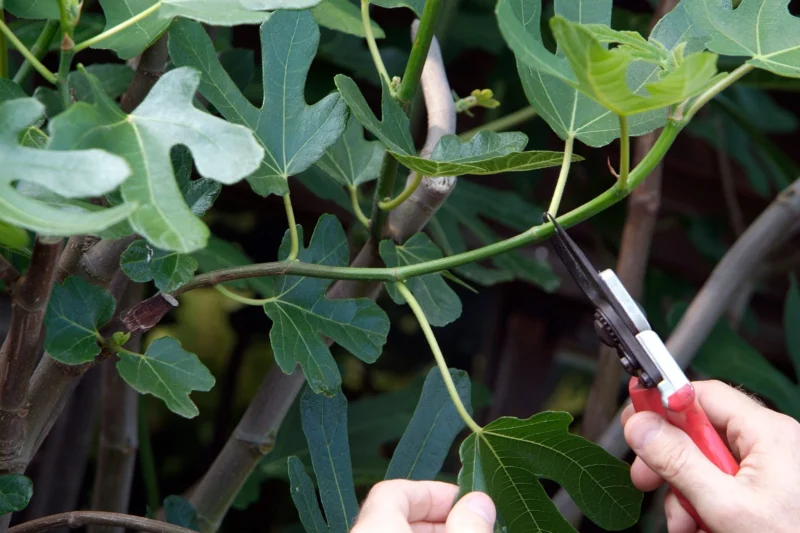Have you ever wondered, “What happens if I don’t prune fig trees in my garden?” Maybe you’re worried about harming the tree or unsure where to start. Don’t worry, I’ve been there too. Fig trees, or Ficus carica, thrive when properly cared for, and pruning plays a huge role in their health and fruit production. Let me show you how easy it can be.
Why Pruning Your Fig Tree Is Essential

Pruning isn’t just about keeping your fig tree looking tidy; it’s a vital part of ensuring its health and productivity. Here’s why:
-
Boosting Fruit Production: Pruning enhances air circulation and allows more sunlight to reach the branches, encouraging the tree to produce larger, sweeter figs.
-
Preventing Diseases: Trimming away dead or diseased branches minimizes the risk of pests and infections, giving your tree a healthier future.
-
Shaping for Manageability: Whether you’re growing in a cozy backyard or a container, pruning helps keep the tree’s size under control and its structure strong.
When I first pruned my fig tree, I’ll admit I was nervous. But following the right steps transformed it into a healthier, more productive tree—and the abundance of sweet figs made it all worthwhile!
When to Prune Fig Trees
When is the best time to prune fig trees? The best time to prune a fig tree depends on your goals.
Winter pruning is ideal for heavy pruning because the tree is dormant, allowing you to clearly see the branches and focus on shaping its structure. On the other hand, summer pruning is lighter and helps control the tree’s size while directing its energy into fruit production.
Winter is the ideal time for heavy pruning as the tree is dormant. However, it’s also important to protect your fig tree from frost damage during this season. Discover our guide on Winter Care for Fig Trees for essential tips to safeguard your tree.
For beginners, winter pruning is the easiest and most effective option, as the tree’s framework is more visible without leaves, making it simpler to identify which branches to cut.
Tools You’ll Need
Before you begin pruning your fig tree, it’s important to gather the right tools to ensure a safe and effective process. The following essentials will make the job easier and protect both you and your tree:
-
Pruning Shears: These are a must-have for cutting smaller branches and fine-tuning the tree’s shape. Look for high-quality, sharp shears with a comfortable grip to reduce hand fatigue during extended use.
-
Loppers: For larger, thicker branches that pruning shears can’t handle, loppers are indispensable. Their long handles provide extra leverage, making it easier to cut through tough wood without straining yourself.
-
Gloves: A good pair of gardening gloves will protect your hands from scratches, sap, and thorns while giving you a better grip on the tools. Choose gloves made from durable yet flexible material for maximum comfort and protection.
-
Disinfectant: Cleaning your tools before and after pruning is crucial to prevent the spread of diseases and pests. Use a household disinfectant, diluted bleach solution, or rubbing alcohol to sanitize your shears and loppers between cuts, especially if you’re working on multiple trees.
Step-by-Step Guide to Pruning Fig Trees
Here’s how to prune your fig tree for success:
Step 1: Assess the Tree
Look for dead, diseased, or damaged branches.
Identify suckers (shoots from the base) and water sprouts (vertical shoots).
Step 2: Remove the Unnecessary
Cut off any dead or diseased wood.
Remove crossing branches to improve airflow.
Step 3: Shape the Tree
Select 4-6 strong main branches to keep.
Ensure an open center for better light and air penetration.
Step 4: Trim for Growth
Shorten branches by one-third to one-quarter.
Always cut above an outward-facing bud.
Step 5: Clean Up
Dispose of the trimmings properly.
Disinfect your tools before storing them.
Pruning Isn’t the Final Step! How to Keep Your Fig Tree Thriving
Pruning is just the beginning of nurturing a strong, productive fig tree. Follow these steps to help it recover and flourish:
-
Water Deeply: After pruning, give your tree a thorough drink. Hydration is key for helping it bounce back and thrive.
-
Add Mulch: Spread a layer of mulch around the base to retain moisture, regulate soil temperature, and suppress weeds. Just keep it a few inches away from the trunk to prevent rot.
-
Monitor Growth: Watch for any signs of pests, disease, or stress as the tree recovers. Early detection can make all the difference in maintaining its health.
Pruning your fig tree doesn’t have to be intimidating. With the right timing, tools, and techniques, you’ll enjoy a healthier tree and a more abundant harvest. So grab your tools and give it a try—you’ll thank yourself when you see the results!
Pruning figs techniques may vary slightly depending on the variety of your fig tree. For instance, the Smith Fig Tree has unique growth habits that benefit from specific pruning strategies. Check out our Comprehensive Review of the Smith Fig Tree to learn more.
FAQs
1. Can I prune fig trees in the summer?
Yes, but keep it light. Summer pruning is ideal for size control and encouraging fruit production.
2. What happens if I don’t prune my fig tree?
The tree may grow unevenly, produce fewer fruits, and become prone to diseases.
3. How much should I prune?
In winter, remove about 20-25% of the tree. Focus on shaping and removing dead wood.
4. Do I need special tools?
Basic tools like pruning shears and loppers are enough for most fig trees. Always disinfect them before use.
